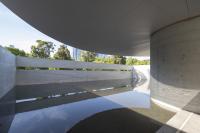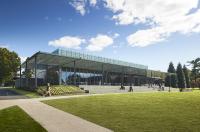Wohnanlage Brielgasse
Bregenz, Austria
Urbanistic stress field – between former industrial area and small housing estates, between city street and biotope
The five well scaled buildings are arranged after two converging axes. This composition supported by neatly arranged differences in height and plantings creates diverse and identity creating exterior spaces.These are at the same time links between urban context and the adjacent nature preserve area.
The site is located at the foot of a 14 meter slope on the transition between loose villa and family-housing above (Riedergasse) and the densely built on industrial area of the former Elektra Bregenz below.
The design mediates between the two structures trough its sculptural appearance. Three buildings are arranged alongside the neighbouring houses in the Brielgasse and two buildings follow the direction of the Riedergasse.
The two groups build a loose row and divide themselves so that different yards, an ideal view and lightning can evolve.
From South to the North there’s a conflict between the heavily frequented Brielgasse and the landscape conservation area Erawäldele. Here the design of the exterior spaces reacts through the green increasing in this direction.
Terrace motive
The first building defines the street space at the Brielgasse. The terrace interacts with the height of the building and continues with this motive which is already brought to the traffic-loaded Brielgasse by the office building from Jean Nouvel as an important quality for pedestrians.
Separated courtyard and access level
The hillside situation is used to separate the traffic and the yards/ playgrounds into two levels: the entrance for cars to the basement garage at the Brielgasse follows a lower level alongside the northwestern property line and ends at about a third of the real estates length. The rest of the space is without traffic and open to children and pedestrians. A footpath connects the street with the existent paths, a continous path system in direction to the community center is developed.
Design of the exterior spaces – spatial quality in the access areas
The freely formed path joins the old Brielgasse and connects the buildings, which are surrounded by islands. The rest of the remaining paved areas and a big central spot serve as movement areas. The halfopen building entrances with partly covered front areas belong to the yards and create multifunctional transitive areas to the access facilities of the buildings. The bike storages are located at prominent spots next to the entrances.
Economic efficiency - sustainability
Our intent was to create a well-balanced mixture of a compact buildung structure and contextual (sustainable) qualities, such as naturally litted staircases, an adequate amount of apartments per staircase and differentiated outdoor areas.
Staircase access via four main routes – double-sided lightning
The splitting of the 5 buildings allows staircase access via four main routes, which offers double-sided lightning and orientation to all apartments. Therefore a natural lightning of all staircases is possible. Because all the staircases are orientated differently, individual floor plans are created.
Sight to three directions – lake view
The inserted corner balconies offer safe exterior areas and sight to three directions. The cantilevers on all sides on each floor guarantee a costructive weather protection and structuring of the facade. The five-storey buildings offer an attractive view to the lake and the Rheintal from the third level on.
Technical description
housing complex with 5 buildings in solid construction above a basement garage
surface foundation, ground-touching basement walls made of concrete. Bearing walls, pilaster and ceilings in STB. Apartment walls in STB with facing formwork
FACADES AND EXTERNAL WALLS: plastered inside, insulation with mineral wool, back ventilated facade, vertical wood boarding.
French doors made of wood and double insulaton glazing and blinds for sun protection
BALCONIES: STB prefabricated parts and wooden grating overlay
BALUSTRADE: frosted glass as privacy protection
GREEN ROOFS
WOOD HEATING (Pellets) with additive solar water heating, situated centrally in house 3. Distribution of the heat with low temperature heating system (floor heating)
SPECIFIC HEAT REQUIREMENT: 36 kW/m2a
The housing complex is entirely barrier-free.
Part of the urban district development Vorkloster
The Vorkloster which is located west of the city center is the district of bregenz which expands the most:
The transformation of the Schöller areal from an industrial area into a mixed utilisation of housing, working and industry which offers the required infrastructure to the surrounding newly built housing complexes (construction of nearly 100 appartments in the last three years) caused this development. The housing complex by the VOGEWOSI in the Brielgasse is another step in this progressing development.
The housing complex is located above the community center around the Mariahilf church with schools, kindergardens, a social centre, a cinema, supermarkets, shops, restaurants, a market hall and is accessible on foot.
Role of the client
The VOGEWOSI commits itself with the housing complex Brielgasse on an inner-city site which meant additional technical expenses due to its location on the hillside. In the planning process a competition with 5 architectural offices was held in which a project won which with a building density of 0,93 went much below the possible building density of 1,1 to realise a reconcilable concept.
Artistic colouring
In the common areas benches and an artistic colouring are additionally offered.
Herefore the artist Brigitte Menschhorn was commisioned to do oil paintings with motives of flowers. The context of this is the fact that the site used to be a market garden. A lot of plants in the neighborhood come from this time and also the heigh box tree at the entrance of the site. Motives of flowers now remind of the history of the site.
The MATERIALISATION happened on a very high level: artificial stone in the corridor areas, apartment doors made of oak, inside the appartments special door elements in oak leading to the living room, coloured inner doors and storage rooms with sliding doors.
- Architects
- Heike Schlauch raumhochrosen
- Location
- Brielgasse, 6900 Bregenz, Austria
- Year
- 2009
- Client
- VOGEWOSI - Vorarlberger gemeinnützige Wohnungsbau- und Siedlungsgesellschaft mbH
- Team
- raumhochrosen - Heike Schlauch und Robert Fabach in Arbeitsgemeinschaft mit A+ZT GmbH Gerhard Gruber













